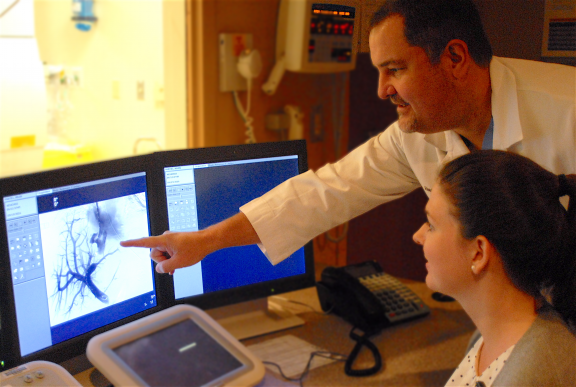The following story originally appeared in the September 2016 edition of the Vanderbilt Radiology Society's "The Reader."
The first discussions about Interventional Radiology (IR) becoming a new residency started about seven years ago. As a third-generation radiologist, I brought a sense of pride and high expectations to these discussions. While it took time to finalize the plans for the new residency curriculum, I think many in our community are proud of what we have created.
The IR program curriculum includes a one-year internship in surgery, three years in diagnostic radiology and two years in IR. This program will produce a clinically savvy, expert diagnostician and proceduralist. Our goal is to cultivate interventional radiologists who can provide state-of-the-art, minimally invasive, image-guided procedures with the clinical chops to consult, manage and follow their own patients.
Here at Vanderbilt, we have the privilege of starting one of the first IR residencies in the country. This year, we were one of only eight institutions to participate in the first full IR match, and we filled our complement of three slots, plus found an intern willing to start as the first “true” IR resident in the country. This accomplishment could not have been possible without the foresight and support of Reed Omary, M.D., M.S., Carol D. and Henry P. Pendergrass Professor and Chair, and Edwin Donnelly, M.D., Ph.D., Associate Professor and Diagnostic Radiology Residency Program Director.
This July, we welcomed our, and the country’s, first IR resident. I am proud to introduce Courtney Raybon, M.D. Her journey is inspiring:
“As a surgery intern at University of California, San Francisco, I spent most of my day caring for patients who had undergone extensive surgeries with a recovery that often included tremendous suffering and frequent setbacks. During this time, I communicated frequently with radiologists, especially neuro- and body-interventional radiologists. I looked forward to visiting the reading room and interventional suites. I soon noticed my interest shifting from surgery to radiology, which lead to the decision to complete an IR rotation.
My first day of my IR rotation was truly a breath of fresh air. I was able to help treat patients in a minimally invasive way, with beautiful, successful results from the procedures. I had found a field of medicine that, similar to surgery, was technically challenging and exciting; yet the morbidity of the procedures was markedly less than those I had just completed in the operating room. I discovered a passion for radiology, and having the opportunity to combine this with my interest in a procedure-oriented specialty is truly the best of both worlds.
When I interviewed, I was aware that Vanderbilt was one of the first of only eight programs in the country to be approved for an IR residency program. What I didn’t realize, at the time, was that coming to the Vanderbilt program as a PGY 2 would make me the first IR resident in the country.
I feel incredibly humbled and privileged to be here. It is such an honor to be at Vanderbilt and a part of this program and community. The path before me is uncharted water, and I can only hope I navigate it with grace and excellence. Thankfully, I know I have the support of wonderful faculty, staff and co-residents who want to see both me, as well as the program, succeed. With feelings greater than those of personal excitement or trepidation, I look forward with great anticipation to the future of IR and the IR residency program.”
